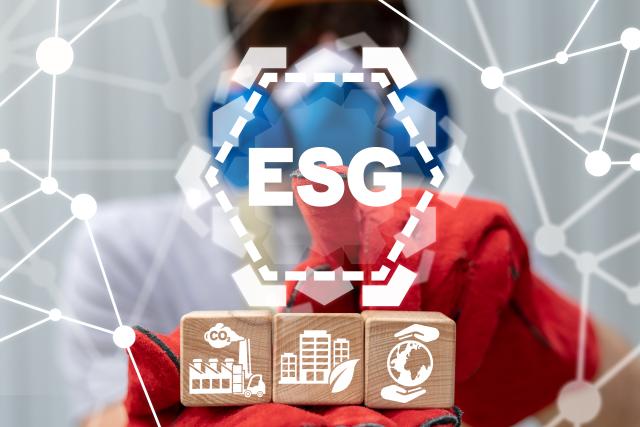
A centralized ESG management and reporting system enables companies to capture, document and report on sustainability metrics while giving management a holistic view of their ESG program.(Source: Shutterstock.com)
If you follow ESG headlines, you’ve probably heard the increasing need for effective ESG messaging as the transition to a low-carbon economy gains global momentum. If energy companies need to achieve long-term value and growth, the first step is outlining an effective ESG strategy with a message that resonates with investors, stakeholders and the public.
Hart Energy recently talked to John Castner, SVP of field operations at IsoMetrix Americas about the future of ESG reporting and how ESG messaging is evolving in the oil and gas industry.
Castner discussed how companies can effectively communicate their ESG commitments to enjoy the “sustainability premium."
“ESG today needs to be more than just PR or greenwashing,” he said, adding that ESG reporting needs to be an integral part of a company’s business plan to effectively convey the message while also managing the health, safety, social and sustainability risks of the company.
Hart Energy: An increasing number of oil and gas companies are putting forward ESG reports to address investor concerns and climate change. How is managing and reporting ESG data evolving in oil and gas?
Castner: It’s increasingly clear that companies actively reporting ESG data are enjoying a competitive advantage. Blackrock recently revealed that companies with better ESG profiles outperformed their peers in 2020. Oil and gas companies are no exception, and if they want to enjoy this “sustainability premium,” they are increasingly realizing that they have to make substantial, meaningful commitments to reporting ESG data as transparently as possible.

In addition, the Biden administration is preparing to implement strict net zero targets on the power sector, and is making climate change a priority. With the prospect of zero-carbon targets and closer regulatory scrutiny, ESG reporting processes are not just useful for providing data to investors, they can also help oil and gas companies manage regulatory concerns as well.
I would say that a lot of oil and gas companies have been “doing ESG” for quite some time. Many of them, especially those who operate in non-U.S. locations, have spent a lot of focus on the S (Social) part of ESG. These are well presented in Sustainability Reports. Certainly, there is a lot of criticism around the E aspect in particular.
Nonetheless, I would say that oil and gas is not too different than many industries who are leveraging Sustainability reports and initiatives as the foundation for ESG reporting. When you look at companies like ExxonMobil, they have also recently appointed board members with a strong background on ESG matters.
Hart Energy: Digital transformation is not new to oil and gas. Can you discuss the role of technology in the future of ESG reporting?
Castner: What we’re seeing is that centralized data collection and management greatly simplifies oil and gas companies’ ESG reporting to investors, customers, rating agencies, regulators and operational stakeholders.
It’s easier to compile meaningful reports if you’ve done a good job of ensuring that all relevant data is up to date and in one place. That’s why a centralized ESG management and reporting system is so important. It provides companies an easy way to prepare for ESG reports, while also managing all health, safety, social, and sustainability risks at the company. It enables companies to capture, document and report on sustainability metrics while giving management a holistic view of their ESG program so they can take a proactive approach in ensuring targets are met.
It’s not uncommon for heads of sustainability and other persons responsible for ESG reporting to spend 60% to 70% of their time collecting ESG data and repurposing the same data sets for different questionnaires. Using an integrated system cuts down that time substantially.
Reports that take days or weeks to compile can be prepared in 10 minutes with the right software in place. Aside from facilitating ESG reporting, a centralized ESG software system can generate powerful dashboards and data visualization that help companies identify operational efficiencies in their business that will lower costs and reduce environmental impacts. A strong ESG data management system also helps to highlight the correct internal metrics that ensure company resources are efficiently utilized and that management is focusing attention on the activities that will reduce ESG-related risks.
Hart Energy: Can you discuss best practices that oil and gas companies can put into place for effective ESG reporting?
Castner: ESG reports can only be as useful as the data that supports them. To get insights into a company’s ESG activities at the operational level, that data needs to be captured “on the ground” from the personnel managing the social, environmental and regulatory risks on behalf of the company.
Meanwhile, having centralized oversight to data management provides a consistent QA/QC to enable ESG data to be rolled up across multiple projects and regulatory regimes for consolidation into a company-level ESG report.
Investors, lenders and regulators alike want to minimize negative impacts while maximizing opportunity—this is what the local stakeholders want, as well. On demand access to manipulatable data visualizations allows for trends to be identified early to easily see the company’s impact on the environment and the community, all while remaining compliant with the regulators. Negative environmental impacts can be addressed promptly and positive social impact can be measured and evaluated. This ensures that ESG risks are sincerely addressed and not merely part of a “check the box” reporting exercise.
Hart Energy: What are some of the procedural and technological changes to ensure transparency in ESG reporting?
Castner: It’s important not to underestimate the importance of managing cultural change when implementing ESG systems. ESG today needs to be more than just PR or greenwashing. It needs to be an integral part of a company’s approach to data measurement and reporting, with hard data, metrics, and visibly documented milestones.
To make that happen requires a concerted effort at all levels of the company, from the board level to the site level. It also requires ESG champions who can spearhead the project and help unify the company behind the effort. This will facilitate a clear understanding of why it is important and establish ownership that can foster valuable behavioral change in how ESG data is captured, and ultimately in meeting company ESG objectives.
ESG champions need to have a clear understanding of relationships, both within their corporation and also in the communities and governments it interacts with. They must be able to get buy-in from different levels and areas of the business, and they have to be able to manage stakeholder relationships carefully. ESG demands a deep understanding of corporate, community, and global relationships. To be successful, it needs buy-in from multiple levels and disparate areas of a business.
Technologically, oil and gas companies are traditionally well equipped with technology solutions. The challenge in ESG Reporting is consolidating all of this data. So having an ESG Data Strategy is really also about understanding the source of that data, and that often means several disparate pieces of technology. Finding the right management system that will bring intelligent connections with data, analytics, and system integration will position oil and gas companies to improve transparency with efficiency and make it sustainable as ESG reporting requirements continue to evolve.
Hart Energy: How can businesses avoid pitfalls when transitioning from siloed to more integrated systems when analyzing ESG data?
Castner: It’s important to assess the company’s needs and formulate a phased approach—with the understanding that you may need to pivot as you continue your ESG journey. An agile software development mindset can be helpful here. Rather than making ESG reporting into a massive, top-down project, it’s more effective to create smaller, achievable ESG projects and use what you’ve learned in achieving each milestone to inform your progress towards the next one. This focuses people while making it more likely that you’ll achieve success in the long run.
Having the right ESG tool is just as critical. Excel—a favorite tool of those in oil and gas—is just not sufficient for managing ESG data across a large, diverse, multinational organization. You need purpose-built ESG solutions that can scale across the organization and which you can customize to fit various national laws, local issues, and specific project needs. Without that, your ESG project is going to get bogged down in a morass of spreadsheets and confusion.
Recommended Reading
Initiative Equity Partners Acquires Equity in Renewable Firm ArtIn Energy
2024-04-26 - Initiative Equity Partners is taking steps to accelerate deployment of renewable energy globally, including in North America.
Energy Transition in Motion (Week of April 26, 2024)
2024-04-26 - Here is a look at some of this week’s renewable energy news, including the close of a $1.4 billion decarbonization-focused investment fund.
No Silver Bullet: Chevron, Shell on Lower-carbon Risks, Collaboration
2024-04-26 - Helping to scale lower-carbon technologies, while meeting today’s energy needs and bringing profits, comes with risks. Policy and collaboration can help, Chevron and Shell executives say.
Solar Sector Awaits Feds’ Next Move on Tariffs
2024-04-25 - A group of solar manufacturers want the U.S. to impose tariffs to ensure panels and modules imported from four Southeast Asian countries are priced at fair market value.
Solar Panel Tariff, AD/CVD Speculation No Concern for NextEra
2024-04-24 - NextEra Energy CEO John Ketchum addressed speculation regarding solar panel tariffs and antidumping and countervailing duties on its latest earnings call.





